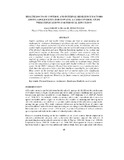Please use this identifier to cite or link to this item:
http://hdl.handle.net/10311/1210| Title: | Health locus of control and internal resilience factors among adolescents in Botswana: a case-control study with implications for physical education |
| Authors: | Shehu, Jimoh Mokgwathi, Martin M. |
| Keywords: | Physical education Adolescents Resilience Health locus of control |
| Issue Date: | 2008 |
| Publisher: | Southern African Alliance for Sport Science, Physical Education and Recreation. http://ajol.info/index.php/sajrs/index |
| Citation: | Shehu, Jimoh & Mokgwathi, Martin M. (2008) Health locus of control and internal resilience factors among adolescents in Botswana: a case-control study with implications for physical education, South African Journal for Research in Sport, Physical Education and Recreation, Vol. 30, No. 2 pp. 95-105 |
| Abstract: | Studies exploring self and health belief systems are keys to understanding the challenges to wholesome development of adolescents and creating interventions to enhance their mental, emotional and physical health status. Accordingly, this case-control study compared internal resilience factors and health locus of control among 1700 physical education and non- Physical Education students in the central and south-central regions of Botswana. The study variables were assessed using the Multidimensional Health Locus of Control Scale (MHLC) (Wallston et al., 1978:165) and a modified version of the Resilience Scale (Wagnild & Young, 1993:160). Analysis of variance of the loci of control and resilience scores were conducted. Although 78% of the resilience scores were well within the moderate range, females across the comparisons groups had significantly higher resilience scores than the males. On the MHLC subscales Physical Education students were significantly more likely than the referents to believe that their health is controlled by powerful others. Mean scores on the internal and chance loci of control scales were significantly higher among the males. Relationships among resilience and locus of control scores were statistically significant. Directions for future research and physical education interventions are offered. |
| URI: | http://hdl.handle.net/10311/1210 |
| ISSN: | 0379-9069 |
| Appears in Collections: | Research articles (Dept of Physical Education) |
Files in This Item:
| File | Description | Size | Format | |
|---|---|---|---|---|
| Shehu_SAJRSPER_2008.pdf | 942.74 kB | Adobe PDF |  View/Open |
Items in DSpace are protected by copyright, with all rights reserved, unless otherwise indicated.
